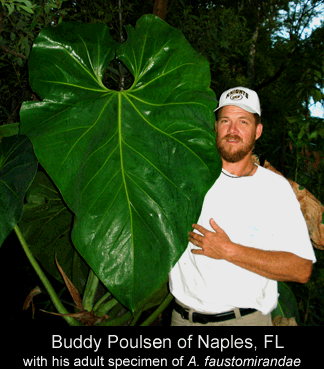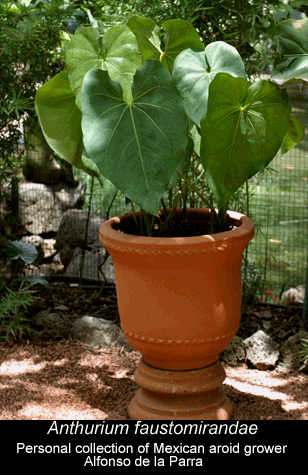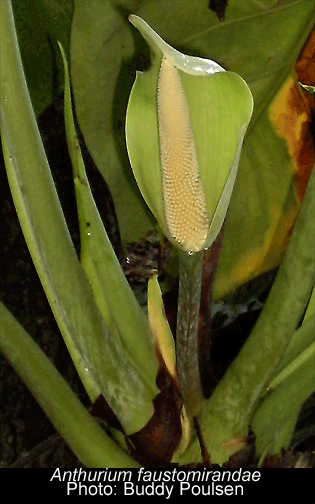![]()
Aroids and other genera in the Collection
Take the Tour Now?
Orchids
The
Exotic Rainforest
Plants in
the Exotic Rainforest Collection
The images on this website are copyright protected. Please contact us before any reuse.
Detailed information on Growing Anthurium
Species Click this Link
The Exotic Rainforest is a private botanical garden.
Within our collection we have many species of Anthurium. If you are seeking other photos, click this link
New: Understanding, pronouncing and using Botanical terminology, a Glossary
Anthurium faustomirandae
Pérez-Farrera & Croat

Often incorrectly spelled
Anthurium faustinomiranda, Anthurium faustino-miranda
Anthurium faustino-mirandae, Anthurium faustinamarino
and sometimes Anthurium faustmirandae on numerous websites
Dr. Croat once proposed but did not publish the name "Anthurium whitelockii" for the plant published to science as Anthurium faustomirandae Pérez-Farrarra & Croat
Faustino's Giant Anthurium
 coriaceous (leathery) and quite stiff. According to aroid expert
Julius Boos,
"the leaves feel like hard, dry cardboard." New
leaf growth
emerges with a red coloration bing on gold and the new
leaves are glossy.
However, as the blade matures and hardens, the gloss is lost and the
blade surface becomes matte.
coriaceous (leathery) and quite stiff. According to aroid expert
Julius Boos,
"the leaves feel like hard, dry cardboard." New
leaf growth
emerges with a red coloration bing on gold and the new
leaves are glossy.
However, as the blade matures and hardens, the gloss is lost and the
blade surface becomes matte.There appears to be some dissention among growers regarding the sinus (opening between the lobes near the top) of the specimen. Many plants have an open sinus but plants may also have lobes that overlap as in LariAnn's photo (left) and Windy Aubrey's photo of a fully adult hybrid specimen at Silver Krome Gardens in Miami, FL (lower right). Aroid expert Julius Boos provided this explanation regarding both the sinus and the size of the species, "Ron Weeks and I had a conversation earlier today, and I asked about the variation, the more open and the more closed sinus on this species. Ron pointed out that Denis Rotolante has huge plants of this species and grows many from the large seeds. There is specific (normal) variation amongst the seedlings. Some sinus develop to be more 'open' than others! Look at the plant with Sam in the picture on Enid`s plant site. Our Mexican friend Alfonso de la Parra brought this photo to my attention. I also
 contacted an
experienced friend
and he says my memory of Dr. Monroe Birdsey`s huge plant is correct.
It was planted in the ground, and was larger than the potted ones we
are now seeing and had leaves approaching five feet!"
As you will read
later, hybrids can be difficult to detect, even by experts.
contacted an
experienced friend
and he says my memory of Dr. Monroe Birdsey`s huge plant is correct.
It was planted in the ground, and was larger than the potted ones we
are now seeing and had leaves approaching five feet!"
As you will read
later, hybrids can be difficult to detect, even by experts.  The species was originally collected
in 1952 by Spanish botanist Faustino Miranda at San Fernando, Mexico but
went unnamed. Miranda considered the species to be Anthurium
xanthosomifolium Matuda as a result of the species' large
leaves. Anthurium xanthosomifolium is now considered a
synonym of Anthurium titanium. In the early1990's, the species was named
in honor of Miranda and is commonly known as Faustino's Giant
Anthurium. Miranda's original collected specimen is still in
cultivation in the Jardin Botanico "Faustino Miranda" at the
Instituto de Historia Natural in Chiapas, Mexico.
The species was originally collected
in 1952 by Spanish botanist Faustino Miranda at San Fernando, Mexico but
went unnamed. Miranda considered the species to be Anthurium
xanthosomifolium Matuda as a result of the species' large
leaves. Anthurium xanthosomifolium is now considered a
synonym of Anthurium titanium. In the early1990's, the species was named
in honor of Miranda and is commonly known as Faustino's Giant
Anthurium. Miranda's original collected specimen is still in
cultivation in the Jardin Botanico "Faustino Miranda" at the
Instituto de Historia Natural in Chiapas, Mexico. The type specimen of Anthurium faustomirandae was collected in the Montañas del Norte region of Mexico near Chiapas on April 16, 1995 at an elevation of 850 meters (2100 feet). Miguel Farrera, who is associated with the Universidad de
 Ciencias y Artes del
Estado de Chiapas, is one of the botanical authors. His
co-author on the species is our friend Dr. Tom Croat of the Missouri
Botanical Garden, in St. Louis. In addition to some limited similarity to
Anthurium regale, Anthurium faustomirandae bears
a resemblance to Anthurium titanium from Guatemala, thus
the original confusion with Anthurium xanthosomifolium.
One major difference in the species is Anthurium
faustomirandae has a persistent intact cataphyll and
much thicker leaf blades and a shorter inflorescence with a wider
spathe. The spathe on a short peduncle is unique since it lies
almost horizontal and as such forms a near perfect 'hood' over the
spadix. The cataphyll is a modified leaf that surrounds a
new leaf blade about to emerge. In some species the
cataphylls soon vanish after the leaf emerges, but in the case of
this species it remains.
Ciencias y Artes del
Estado de Chiapas, is one of the botanical authors. His
co-author on the species is our friend Dr. Tom Croat of the Missouri
Botanical Garden, in St. Louis. In addition to some limited similarity to
Anthurium regale, Anthurium faustomirandae bears
a resemblance to Anthurium titanium from Guatemala, thus
the original confusion with Anthurium xanthosomifolium.
One major difference in the species is Anthurium
faustomirandae has a persistent intact cataphyll and
much thicker leaf blades and a shorter inflorescence with a wider
spathe. The spathe on a short peduncle is unique since it lies
almost horizontal and as such forms a near perfect 'hood' over the
spadix. The cataphyll is a modified leaf that surrounds a
new leaf blade about to emerge. In some species the
cataphylls soon vanish after the leaf emerges, but in the case of
this species it remains. An aroid, all Anthurium species reproduce via the production an inflorescence. The stalk that supports the entire inflorescence is the peduncle. When an Anthurium is "in flower" the reference is to the tiny flowers containing both male and female sexual parts that grow on the spadix at the center of the inflorescence. Unlike plants in the genus Philodendron which contain imperfect flowers having only a single sex Anthurium possess perfect flowers containing both sexes. To help prevent self pollination nature has designed the female flowers to be receptive before the male portion of the flower produce their pollen so in most cases an insect must bring pollen from another plant.
At the present time, Anthurium faustomirandae has been placed in Anthurium section Calomystium as a result of its persistent intact cataphylls and subterete (less than cylindrical) petioles along with a thick spathe and spadix (for those unfamiliar with aroid species, the spathe and spadix are the inflorescence produced by the plant often referred to as a "flower" (see photo right, below). Rather than a "flower", the spathe is simply a modified leaf. However, at this time, the placement in section Calomystrium is tentative. The species is thought to be unique and is isolated from other distinct
 species in the same section
including plants from further south in Central America. This is
important to the preservation of the species since similar
Anthurium species often interbreed and
create natural hybrids
in their native regions. Denis Rotolante explained in a recent
email the photo
by Windy Aubrey (right) was taken at Silver Krome Gardens in
Miami, FL and is actually a hybrid variation. Bill
Rotolante hybridized the specimen by crossing
Anthurium faustormirandae with Anthurium clarinervium.
Denis further explained,
"it has also been
successfully hybridized with Anthurium podophyllum. Dr. Croat
says Central American Anthurium will often hybridize with other
Central American species which are not in their group."
species in the same section
including plants from further south in Central America. This is
important to the preservation of the species since similar
Anthurium species often interbreed and
create natural hybrids
in their native regions. Denis Rotolante explained in a recent
email the photo
by Windy Aubrey (right) was taken at Silver Krome Gardens in
Miami, FL and is actually a hybrid variation. Bill
Rotolante hybridized the specimen by crossing
Anthurium faustormirandae with Anthurium clarinervium.
Denis further explained,
"it has also been
successfully hybridized with Anthurium podophyllum. Dr. Croat
says Central American Anthurium will often hybridize with other
Central American species which are not in their group."Our specimen (photo at top of the page) is still a juvenile and was a gift from our friend and Mexican grower Alfonso de la Parra. Alfonso has his home in an incredible garden approximately one hour west of Mexico City complete with over 30 exotic macaws and other tropical birds. Alfonso arranged for us to receive the specimen at the 2007 International Aroid Show in Miami. Growers claim the species prefers a very wet cycle followed by a slightly drier period followed again by another extremely wet period. We grow our specimen in a mixture of moisture control potting soil, peat, Perlite™, and orchid potting media that contains both bark, charcoal, and gravel. The mixture is kept moderately moist most of the time. The species appears to grow well in either bright or moderate light.
This link explains in greater detail the science of natural variation in Anthurium and other species. You may be surprised to learn that not every leaf of every plant will always look exactly the same. Click here.
Looking for a specimen? Contact
http:///

http://www.briansbotanicals.net/index2.html
or